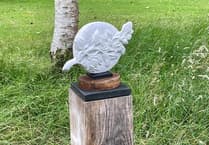They’ve arrived! Just before Easter last year, Transition Tavistock welcomed a pallet load of cardboard boxes. Nestling inside: not eggs, but 6,000 Walkable Tavistock maps. After six months exploring the town, searching out funding and video-calls with the map designer, we had the only up-to-date printed street map of our home town ready to share – free.
With the Tamar Valley to one side, and Dartmoor on the other, why bother with walking in a town? The Ramblers do great work encouraging countryside walking. Slow Ways networks walkable routes between British towns. Our map complements these, revealing connections across town via paths through green spaces, and the web of – hang on, what are they called round here? Advocates for “ginnels”, “snickets”, “alleyways” etc compromised on “cut-throughs” for paths links between streets.
Surely locals know these and visitors look at phones? As the project took shape, even long-term residents spotted new links. Online maps do offer routes on foot, cycle or public transport, as well as car – but only if asked, and can miss some walkable short cuts. Demand from the main distribution points at Tavistock’s Library and Visitor Centre has confirmed the value of a pocket-sized printed map (also viewable online at www.transitiontavistock.org.uk/walkmap).
We supply copies to public and voluntary organisations in the local Health and Wellbeing Alliance. They encouraged this project, seeing how everyday walking supports physical and mental wellness. (“A really positive source of information to share with our clients” said one group.) There’s connection with nature, people and place that you don’t get from inside a vehicle. Guided by wheelchair users, the map shows which cut-throughs have steps or very steep slopes. It plots pedestrian crossings, bus stops and destinations like schools, churches, parks and shopping areas.
Funding came from councillors’ locality budgets and local charities. We appreciate their support for a project that didn’t tick the usual boxes on grant applications. Those favoured taking people on walks rather than informing their choice, and didn’t recognise leaving the car at home as an option to cut the cost of living.
For Transition Tavistock, wider benefits of walking for short trips include lower carbon emissions, less traffic congestion and cleaner air. A map can help people make the best of what’s there, but not remove obstacles. For example, ours highlights some roads with no pavement. On many others pavement swaps sides randomly, or vanishes at a junction, where most needed.
Will new homes be better connected? As the map launched shortly before local elections, we provided copies for new councillors’ induction packs, as a practical tool and a prompt for more walkable towns and villages. Share that vision? Get in touch – there’s plenty more to do.
Transition Tavistock seeks to bring the Tavistock community together to share knowledge and practical ideas on using less energy and resources, growing more food and supply and buy more locally.
The organisation’s goal is to help build a strong and self-supporting community for Tavistock, seizing the opportunity to bring about a sustainable and better future.





Comments
This article has no comments yet. Be the first to leave a comment.